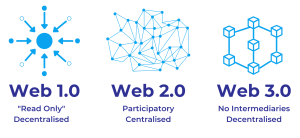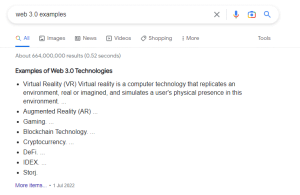How to Generate Leads Online for Free
Every single business has the same goal of attaining leads, whether that means attracting new…
It is difficult to imagine where we’d all be without the internet. It’s our first port of call whenever we have a query that needs a quick answer, how we stay connected with our loved ones, and how many of us choose to be kept entertained. However, the internet has come a long way since the first static website was launched in 1991, in what was known as web 1.0. The launch of social media brought about web 2.0Web 2.0 is a term used to describe the web's transition from a place where documents are created and read to a place where people collaborate and create together., and now everyone is questioning, “is there a web 3.0Web 3.0 is a decentralised version of the internet that corporations or governments do not control.?” This is the supposed next big thing for the internet. What is this new iteration of the internet, and what impact will it have? We’ve put together this handy guide that will get you up to speed in no time.
To understand the answer to “what is web3?”, it is helpful to first look back at the earlier iterations of the internet: web 1.0 and web 2.0.
Web 1.0, also known as the static web, refers to the first stage of the World Wide Web, which involved static read-only websites purely for information purposes rather than interactivity. Only a few were in charge of creating content, and information was often hard to come by.
The term web 2.0 was first introduced in 1999, but it wasn’t used widely until 2004. It is the version of the internet users are familiar with today and refers to user-generated websites, such as social media, that emphasise the importance of user experience. Examples of websites that are part of web 2.0 include Wikipedia, Facebook, and YouTube.

Web 3.0 is a decentralised version of the internet that corporations or governments do not control. This means that users can interact and make transactions between parties without a third party overseeing the act. With web 3.0, privacy, ownership, and transparency take centre stage. So you might be wondering, is web 3.0 here? The answer is it is a work in progress.
Interestingly, this isn’t the first time decentralisation has been mentioned regarding the internet. In the 1990s, internet missionary Tim Berners-Lee introduced the notion of the semantic web, which focused on a ‘bottom-up’ design where everyone could get involved in creating web pages. Arguably web 3.0 and the semantic web are related, but web 3.0 goes beyond this. Web 3.0 uses blockchain technology which powers cryptocurrency and NFT trading and artificial intelligence (AI), meaning it supports the transfer of control and decision-making for currency and finance to other networks.
These are the web 3.0 main features:
Now you know what web 3.0 is, what are some examples of top web 3.0 websites? A quick Google search will throw up a web 3.0 sites list. However, with web 3.0, almost everything has the potential to become decentralised, from social media to trading. Diaspora is an example of a social network that puts web 3.0 into practice, as does Uniswap, which is a currency exchange site.

The third generation of the internet is still being developed. However, some web 3.0 examples of technologies are emerging thanks to their uniquely controlled nature. These include technologies that relate to cryptocurrencies:
This version of the internet is appealing to many, and it brings plenty of advantages for users. One of the biggest areas where web 3.0 is most beneficial is in the finance and bitcoin sectors
It makes transactions more transparent, meaning that no third party has to oversee transactions, and users have more control over their money. The nature of web 3.0 also means that transactions are sped up, meaning quicker borrowing, lending and deposits can occur.
Other benefits include:
To use websites today, users have to provide personal information to do so. Once you hand over this info, it is no longer in your control, and platforms can earn money from this data in various ways. With web3 0, this is not the case, as users have complete control over their data and are not obliged to share this to access content.
Web 3.0 Internet of Things connectivity means that users can access any information from anywhere with any device, which means you can connect to the internet without using your computer or smartphone.
Secure blockchain technology means that user data is protected and the user is safeguarded.
Web 3.0 makes everything quicker and more accessible. Users are not discriminated against based on their socio-economic background, income, race, gender, or sexual orientation to access information. They can also transfer assets quickly, meaning they can realise the internet’s full potential.
While the potential of the tools and services of web 3.0 is infinite, there are some concerns relating to this third wave of the internet. The likes of cybercrime and misinformation are already difficult to control in web 2.0, and with a different version of the internet, this will be even harder. It would also make the application and enforcement of the law tricky because of the lack of central control.
The potential for web 3.0 is never-ending. A new version of the internet puts the control back in users’ hands. It brings with it an increased prevalence of cryptocurrencies such as bitcoin and arguably provides better security and freedom for users. However, it comes with its downsides, too – meaning this version of the internet will be impossible to police, and cybercrime could become more frequent.
To answer, is web 3.0 already here? It isn’t, but each version of the internet took decades to develop. However, with the current increased use of protocols, such as cryptocurrencies, it may not be that far away.
Link Building or Managed SEO which is right for me?
Selecting an SEO agency is an important decision for any business. Check out our guide on how to choose an SEO agency successfully!